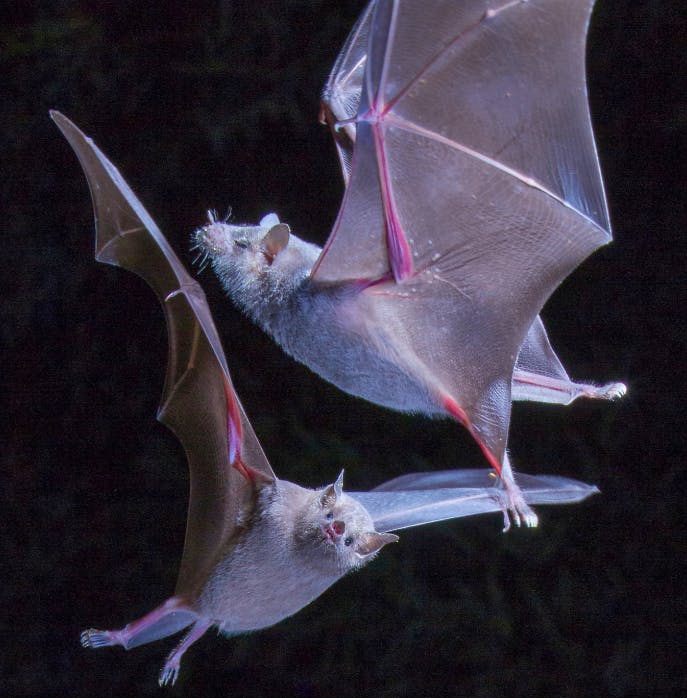As the last rays of light fade on the Arizona desert landscape, they catch the milk-white blossoms that are just beginning to open atop a large saguaro cacti. These 3-inch-in-diameter flowers only bloom at night and rely on two migrating bat species for pollination.
Eat up more fascinating facts about bat pollination in this Q&A with Defenders’ Southwest Director Bryan Bird and learn how a bat pollinates, what plants bats pollinate in the United States and how to help bats thrive.
How do bats pollinate?
Bat pollination is done by nectivorous bats, or those who eat nectar. These bats have evolved unique characteristics – like their long, hairy tongues and hairy body parts – that help them reach nectar and collect pollen. The plants which these bats pollinate also have special adaptations, including having large, bell-shaped, pale nocturnal flowers.
The pollination process itself happens in four quick steps:
- A bat drinks nectar from flowers.
- Pollen sticks to the hair on the bat’s body.
- The bat flies to another plant for more food.
- The pollen on the bat’s body from the first plant is transferred to the next plant.
These plants and bats are often co-dependent, meaning they need each other for survival and reproduction.
What species of pollinating bats are native to the U.S.?
Though nectivorous bats are common in the tropics, there are just two known, nectar-feeding bats in the U.S.: the lesser long-nosed bat and the Mexican long-tongued bat. These bats are migratory, and their range covers Mexico and the southern parts of Texas, California, New Mexico and Arizona.
These bats are known to follow a “nectar trail” as they migrate to stay well-fueled. They spend summers in Arizona and New Mexico before migrating south into central and southern Mexico for the winter.
What plants do bats pollinate in the U.S.?
Bats in the U.S. are known to pollinate saguaro cactus, agave — a key ingredient in tequila — and organ pipe cactus among other plants. The saguaro and agave depend largely on bat pollination, making the bats an indispensable natural ally.
Bats generally pollinate plants that bloom at night and prefer nectar-rich, highly fragrant blooms with a musty, fruity aroma. Their preferred flowers are usually tube- or funnel-shaped. Other bat pollinated plants in the U.S. include evening primrose, datura and honeysuckle.



Are bat-pollinated plants important to humans?
The saguaro and agave have innumerable ecological benefits. They are both keystone species and provide food, shelter and nesting sites to several animals.
The agave has significant economic value to humans too. It is the main ingredient in tequila as well as many beauty and health products. The iconic saguaro cactus attracts visitors to southeastern Arizona and increases the value of real estate in the region.
Are there other species that pollinate these plants or are bats the primary pollinators?
There are other species that pollinate agave and saguaro, but bats take up most of the nocturnal work and are the main pollinator for these two plants.
What are the biggest threats to our bat pollinators?
If our pollinating bats don't have the plants to provide pollen and nectar, these bat populations will suffer declines. Modification of food sources by development, wildfire or livestock grazing can cause direct loss of pollinator plants.
Additionally, bats rely on their roosting habitats which are most often caves and mines and rock crevices. They are very sensitive to their surroundings and tend to fly out of the roost when disturbed. Recreational caving, natural or intentional mine closures, renewed mining and mine reclamation are all additional threats to our native bat pollinators.
Are Mexican long-tongued or lesser long-nosed bats endangered?
Though the Mexican long-tongued bat is extremely rare in the U.S., it is not listed on the endangered species list.
The lesser long-nosed bat was listed as endangered but delisted in 2018 due to its recovery as determined by the U.S. Fish and Wildlife Service. Collaborative recovery under a Habitat Conservation Plan has secured much of the bats’ roosting sites and foraging habitat for the time being.
How can our readers support bat pollination and the bats in their backyard?
One of the best ways to support pollinating bats is to purchase bat-friendly tequila and food products. Bat-friendly tequila producers allow a portion of their agave crop to flower whereas traditional production harvests the crops before flowering, disrupting the pollination process.
We can all advocate for bat habitat protection. Write to your representatives and speak out at local hearings against converting prime bat habitat. When you are out exploring, respect cave closures to avoid disturbing hibernating bats.
You can also provide bat habitat in your own backyard by building and installing a bat box and leaving dead and dying trees for bats to use as roosting sites.














Follow Defenders of Wildlife
facebook bluesky twitter instagram youtube tiktok threads linkedin